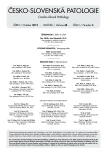Pleomorphic adenoma of salivary glands: diagnostic pitfalls and mimickers of malignancy
Authors:
A. Skálová 1; P. Andrle 2; L. Hostička 2; M. Michal 1
Authors‘ workplace:
Šiklův ústav patologie, Univerzita Karlova v Praze, Lékařská fakulta v Plzni
1; Stomatologická klinika, Oddělení maxillo-faciální chirurgie, Univerzita Karlova v Praze, Lékařská fakulta v Plzni
2
Published in:
Čes.-slov. Patol., 48, 2012, No. 4, p. 179-183
Category:
Reviews Article
Overview
Pleomorphic adenoma is the most common salivary gland tumor, characterized by a complex biphasic proliferation of epithelial and myoepithelial cells intermingled with a mezenchymal component with frequent metaplastic changes and protean histomorphology of the cells. This review describes several unusual histological findings in pleomorphic adenoma that may mimic malignancy, and therefore they represent a diagnostic pitfall. Intravascular invasion of tumor cells is generally suspicious of malignancy; however, intravascular tumor deposits may be rarely found within the capsule of clinically benign salivary pleomorphic adenomas. It is important not to render a malignant diagnosis in such neoplasms, in the absence of other evidence of malignancy. Pleomorphic adenomas, particularly of minor glands of palate, may contain large areas of squamous and mucinous metaplasia suspicious of mucoepidermoid carcinoma (MEC). In contrast to MEC, metaplastic pleomorphic adenomas do not harbour the distinctive translocations t(11;19) and t(11;15), they are not invasive, in contrast they reveal at least focally myxochondroid stroma. Cribriform structures in pleomorphic adenoma may mimic adenoid cystic carcinoma. Oncocytic metaplasia in cellular rich pleomorphic adenoma/myoepithelioma may be associated with significant nuclear polymorphism and hyperchromasia suspicious of malignancy. The most common pitfall in diagnosis of pleomorphic adenoma is so called “atypical PA” that must be distinguished from early malignant transformation to in situ-carcinoma ex pleomorphic adenoma.
Keywords:
salivary gland – pleomorphic adenoma – pitfall – metaplasia – intravascular tumor deposits – atypical – carcinoma ex pleomorphic adenoma
Sources
1. Barnes L, Eveson JW, Reichert PA, Sidransky D, eds. World Health Organization classification of tumours. Pathology and genetics of head and neck tumours. Lyon: IARC Press; 2005.
2. Altini M, Coleman H, Kienle F. Intra-vascular tumour in pleomorphic adenomas: a report of four cases. Histopathology 1997; 31: 55–59.
3. Coleman H, Altini M. Intravascular tumour in intra-oral pleomorphic adenomas: a diagnostic and therapeutic dilemma. Histopathology 1999; 35: 439–444.
4. Skálová A, Altemani A, Di Palma S, et al. Pleomorphic adenoma of salivary glands with intravascular tumor deposits: a diagnostic pitfall. Am J Surg Pathol 2012. In press.
5. Mete O, Asa SL. Pathological definition and clinical significance of vascular invasion in thyroid carcinoma of follicular epithelial derivation. Mod Pathol 2011; 24: 1545–1552.
6. Ozaki O, Ito K, Sugino K. Clinico-pathologic study of pulmonary metastasis of differentiated thyroid carcinoma: age-, sex-, and histology-matched case control study. Int Surg 1993; 78: 218–220.
7. Furlan JC, Bedrad YC, Rosen IB. Clinicopathologic significance of histologic vascular invasion in papillary and follicular thyroid carcinoma. J Am Coll Surg 2004;198:341–348.
8. Lam KY, Ng IOL, Chan GSW. Palatal pleomorphic adenoma with florid squamous metaplasia: a potential diagnostic pitfall. J Oral Pathol Med 1998; 27: 407–410.
9. Behboudi A, Enlund F, Winnes M, et al. Molecular classification of mucoepidermoid carcinomas-prognostic significance of the MECT1-MAML2 fusion oncogene. Genes Chromosomes Cancer 2006; 45: 470–481.
10. Nakayama T, Miyabe S, Okabe M, et al. Clinicopathological significance of the CRTC3-MAML2 fusion transcript in mucoepidermoid carcinoma. Mod Pathol 2009; 22: 1575–1581.
11. Kazakov DV, Belousova IE, Bisceglia M, et al. Apocrine mixed tumor of the skin (“mixed tumor of the folliculosebaceous-apocrine complex”): spectrum of differentiations and metaplastic changes in the epithelial, myoepithelial, and stromal components based on a histopathologic study of 244 cases. J Am Acad Dermatol 2007; 57: 467–483.
12. Brachtel EF, Pilch BZ, Khettry U, et al. Fine-needle aspiration biopsy of a cystic pleomorphic adenoma with extensive adnexa-like differentiation: differential diagnostic pitfall with mucoepidermoid carcinoma. Diagnos Cytopathol 2003; 28: 100–103.
13. Schmidt LA, Olsen SH, McHugh JB. Cutaneous adnexal differentiation and stromal metaplasia in palate pleomorphic adenomas: a potential diagnostic pitfall that may be mistaken for malignancy. Am J Surg Pathol 2010; 34: 1205–1210.
14. Hamperl H. Beitrage zur normalen and pathologischen Histologie menschlicher Speicheldruse. Z Mikroscopisch-Anatomischer Forschung 1931; 27: 1–22.
15. Skálová A, Michal M, Ryška A, et al. Oncocytic myoepithelioma and pleomorphic adenoma of the salivary glands. Virch Arch 1999; 434: 537–546.
16. Auclair P, Ellis GL. Atypical features in salivary gland mixed tumors: their relationship to malignant transformation. Mod Pathol 1996; 9: 652–657.
17. Ellis GL, Auclair P, eds. Tumors of the salivary glands. AFIP Atlas of Tumor Pathology, 4th Series, Fascicle 9. Silver Spring, Maryland: ARP Press; 2008: 69–70.
18. Takeda Y. An immunohistochemical study of bizarre neoplastic cells in pleomorphic adenoma: its cytological nature and proliferative activity. Pathol Intern 1999; 49: 993–999.
19. Di Palma S, Skálová A, Vaněček T, et al. Non-invasive (intracapsular) carcinoma ex pleomorphic adenoma: recognition of focal carcinoma by HER-2/neu and MIB1 immunohistochemistry. Histopathology 2005; 46: 144–152.
Labels
Anatomical pathology Forensic medical examiner ToxicologyArticle was published in
Czecho-Slovak Pathology

2012 Issue 4
Most read in this issue
- Pleomorphic adenoma of salivary glands: diagnostic pitfalls and mimickers of malignancy
- Histiocytic necrotizing lymphadenitis / Kikuchi-Fujimoto disease (HNL/K-F) and its differential diagnosis: analysis of 19 patients
- Pseudotumors of the central nervous system
- Expression of p57 marker in differential diagnosis of complete and partial mole – correlation with DNA analysis
